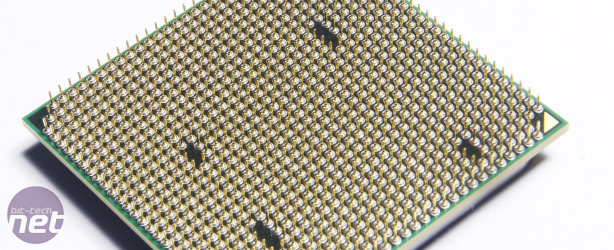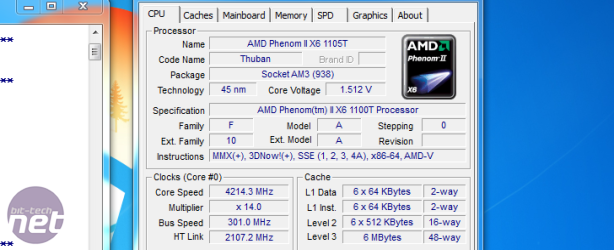
Performance Analysis
The Phenom II X6 1100T Black Edition started strongly in our raft of CPU tests, though we were expecting this as the first few tests we run are heavily multi-threaded. The chip excelled in Cinebench R10 for example, scoring 18,821 at stock speed which is just a whisker behind the £230 Intel Core i7-950. It also performed well at stock speeds in WPrime, though curiously the CPU that the 1100T BE is due to replace, the slower 1090T BE, was slightly quicker in this test.Naturally our 4.2GHz overclock bumped these scores up a fair amount too - the 23,624 the 1100T BE scored in Cinebench when overclocked represents a 25 per cent improvement which is a great result. WPrime saw similar improvements, with the 1100T BE skipping ahead of even the i7-950 when overclocked.
Unfortunately, results were a little less spectacular in our Media Benchmarks. The 1100T BE’s score of 1,181 in our image editing test was behind even mid-range Intel chips such as the £140 2.8GHz Intel Core i5-760. The 1100T BE was a fair way up the performance table in the heavily multi-threaded video encoding test, but it was poor in the multi-tasking test.
These results combined to give the 1100T BE an overall stock speed score of 1,442. While this is faster than its forbear, the 1090T BE, it was way behind similarly priced Intel chips such as the Core i7-930.
The 1100T BE’s relatively impressive overclock helped matters, but given that the Intel CPUs it compets with also overclock very well, it was always going to struggle to overhaul the gap. The Overall Media Benchmark score of 1,727 is an impressive 20 per cent improvement over its stock-speed score, but even this improvement was eclipsed by the Intel chips. The i5-760, for example, saw a 40 per cent increase in its overall score when overclocked.
Gaming also proved to be a disappointment for the 1100T BE - its minimum frame rate of 22fps in Crysis put it near the bottom of our performance table despite having six cores running at 3.3GHz. We saw impressive improvements after our overclocking efforts, though, with the minimum frame rate in Crysis jumping from a jerky 22fps to a smooth 30fps. Again, even this improvement wasn’t enough for the 1100T BEto catch the competing Intel CPUs when they were overclocked.
Power consumption figures for the 1100T BE were broadly in line with our expectations. The chip consumed a little more power than its slower sibling, the 1090T BE, at stock speeds but significantly more when overclocked. This isn’t such a surprising result given that we applied a little more vcore to the 1100T BE than to the 1090T BE.
Conclusion
If we were judging the 1100T BE in isolation you’d probably be seeing a big shiny gold circle just a few inches below this paragraph. The CPU improves on the previous 1090T BE at stock speeds due to its slight clock bump, and it also proved to be a lot more overclockable than the older chip.In the real world, there’s the problem of Intel and it’s frankly unfairly good chips. The £140 Core i5-760 beats the 1100T BE comprehensively in everything but heavily multi-threaded tasks, with the £210 Core i7-930 even further off into the distance. And then there’s the spectre of Intel’s Sandy Bridge, with rumours telling us that this mid-range CPU family could overtake even LGA1366 processors for outright performance.
Our final comment on the 1100T BE will be similar to that in our AMD Phenom II X6 1090T Black Edition review: the CPU is good if you have a compatible motherboard already and need the extra graphics rendering or video editing power of a 6-core CPU. If you’re building from scratch, Intel still has the best CPUs at the moment, and has a brand new range coming out in early January.
- Performance
- x
- x
- x
- x
- x
- x
- x
- -
- -
- -
- 7/10
- Value
- x
- x
- x
- x
- x
- x
- x
- -
- -
- -
- 7/10
- Overall
- x
- x
- x
- x
- x
- x
- x
- -
- -
- -
- 7/10

MSI MPG Velox 100R Chassis Review
October 14 2021 | 15:04










Want to comment? Please log in.